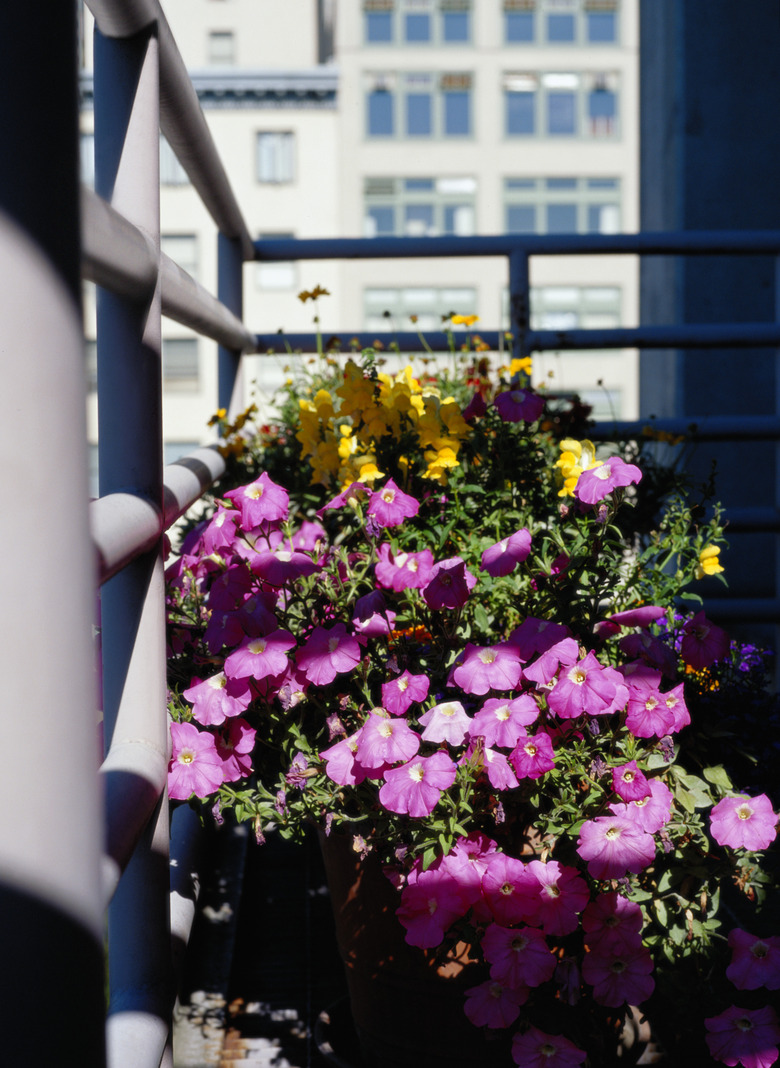How To Revive Petunias
Petunias (Petunia x hybrida) bloom prolifically from spring until fall, creating a splash of bright color in container gardens and raised beds. These tender plants are grown as annuals in U.S. Department of Agriculture plant hardiness zones 2 through 12. The tubular blooms range in color from pure white to deep shades of red, pink and purple, attracting hummingbirds to the garden. Although petunias prefer at least five or six hours of direct sunlight a day, they sometimes get scraggly and cease blooming in mid-summer when the weather is hot and dry. Fortunately, petunias revive quickly when given the right care.
Step 1
Step 1
Apply a vitamin and hormone-based transplant solution to the petunias that show signs of transplant shock, such as severe wilting. These formulas are available under several brand names and work by boosting root growth. Most formulas are highly concentrated. Mix 1/4 teaspoon to 1 gallon or water, unless otherwise indicated on the container.
- Petunias (Petunia x hybrida) bloom prolifically from spring until fall, creating a splash of bright color in container gardens and raised beds.
- Apply a vitamin and hormone-based transplant solution to the petunias that show signs of transplant shock, such as severe wilting.
Step 2
Step 2
Deadhead petunias by snapping the faded blooms from the vine. When flowers are allowed to remain on the vine and go to seed, the plant gets the message that its job is done. Deadheading the old flowers tricks the plant into thinking it hasn't produced enough flowers to set seed and reproduce. As a result, the plant continues to produce new blooms. Some vining petunias, such as WAVE petunias (Petunia x hybrida WAVE), don't require deadheading, but won't be harmed by the practice.
Step 3
Step 3
Examine the foliage of your petunia plants. If the leaves are limp and wilted, but remain green and pliable, watering may be all that is needed to revive them. Water them thoroughly until water runs freely through the bottom of the pot or, in the ground, until the soil is well soaked. Keep the soil evenly moist. Wilted foliage typically revives within the hour, returning your petunias to their usual beauty.
- Deadhead petunias by snapping the faded blooms from the vine.
- Deadheading the old flowers tricks the plant into thinking it hasn't produced enough flowers to set seed and reproduce.
Step 4
Step 4
Cut petunias back to within 2 inches from the soil level if the foliage has become crisp and dry. Otherwise, the Oregon State University extension service, Northwest Gardens, recommends cutting petunias back to a height of 6 inches when they become scraggly. This forces new growth along the stem. A second flush of blooms will appear within a few weeks. Water thoroughly after cutting the plant back.
Step 5
Step 5
Move petunias in hanging baskets or containers to a sheltered location where they are shaded during the hottest part of the day, or provide shade for those grown in the soil. Erecting shade clothes or other structures to cast shade on the area during the hottest part of the day prevents undue stress from the sun's rays to the already struggling plants.
- Cut petunias back to within 2 inches from the soil level if the foliage has become crisp and dry.
Step 6
Step 6
Apply water-soluble fertilizer designed for blooming plants mixed at a rate of 1 tablespoon per gallon of water, on a seven- to 14-day schedule. This is especially important for petunias grown in containers as nutrients leach through the bottom of the pot with each watering and must be replaced to support healthy growth. Supplying the proper nutrients to your petunias revives slow or stunted growth from a lack of nutrients.
Tip
Petunias require evenly moist soil that drains well. Plants in containers may require daily watering while those in the soil require deep watering to saturate the soil to the root level once or twice a week or whenever the soil dries 1 inch below the surface.
Warning
Petunias allowed to sit in dry soil for extended periods cannot be revived if the roots have died.
Warning
Do not move petunias grown in the soil while they are under stress. If transplanting to a shadier area is necessary, do it in the evening when the weather has cooled and the plant has revived from the effects of the afternoon sun.
Things Needed
- Garden shears
- Water-soluble fertilizer
